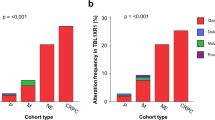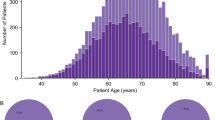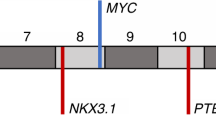Abstract
Gene fusions, mainly between TMPRSS2 and ERG, are frequent early genomic rearrangements in prostate cancer (PCa). In order to discover novel genomic fusion events, we applied whole-genome paired-end sequencing to identify structural alterations present in a primary PCa patient (G089) and in a PCa cell line (PC346C). Overall, we identified over 3800 genomic rearrangements in each of the two samples as compared with the reference genome. Correcting these structural variations for polymorphisms using whole-genome sequences of 46 normal samples, the numbers of cancer-related rearrangements were 674 and 387 for G089 and PC346C, respectively. From these, 192 in G089 and 106 in PC346C affected gene structures. Exclusion of small intronic deletions left 33 intergenic breaks in G089 and 14 in PC346C. Out of these, 12 and 9 reassembled genes with the same orientation, capable of generating a feasible fusion transcript. Using PCR we validated all the reliable predicted gene fusions. Two gene fusions were in-frame: MPP5–FAM71D in PC346C and ARHGEF3–C8ORF38 in G089. Downregulation of FAM71D and MPP5–FAM71D transcripts in PC346C cells decreased proliferation; however, no effect was observed in the RWPE-1-immortalized normal prostate epithelial cells. Together, our data showed that gene rearrangements frequently occur in PCa genomes but result in a limited number of fusion transcripts. Most of these fusion transcripts do not encode in-frame fusion proteins. The unique in-frame MPP5–FAM71D fusion product is important for proliferation of PC346C cells.
This is a preview of subscription content, access via your institution
Access options
Subscribe to this journal
Receive 50 print issues and online access
$259.00 per year
only $5.18 per issue
Buy this article
- Purchase on Springer Link
- Instant access to full article PDF
Prices may be subject to local taxes which are calculated during checkout





Similar content being viewed by others
References
Siegel R, Naishadham D, Jemal A . Cancer statistics, 2012. Cancer J Clin 2012; 62: 10–29.
Shen MM, Abate-Shen C . Molecular genetics of prostate cancer: new prospects for old challenges. Genes Dev 2010; 24: 1967–2000.
Tomlins SA, Rhodes DR, Perner S, Dhanasekaran SM, Mehra R, Sun X-W et al. Recurrent fusion of TMPRSS2 and ETS Transcription factor genes in prostate cancer. Science 2005; 310: 644–648.
Dong J-T . Chromosomal deletions and tumor suppressor genes in prostate cancer. Cancer Metastasis Rev 2001; 20: 173–193.
Clegg NJ, Couto SS, Wongvipat J, Hieronymus H, Carver BS, Taylor BS et al. MYC cooperates with AKT in prostate tumorigenesis and alters sensitivity to mTOR inhibitors. PLoS One 2011; 6: e17449.
Cheng I, Levin AM, Tai YC, Plummer S, Chen GK, Neslund-Dudas C et al. Copy number alterations in prostate tumors and disease aggressiveness. Genes Chromosomes Cancer 2011; 51: 66–76.
Jin G, Sun J, Liu W, Zhang Z, Chu LW, Kim S-T et al. Genome-wide copy-number variation analysis identifies common genetic variants at 20p13 associated with aggressiveness of prostate cancer. Carcinogenesis 2011; 32: 1057–1062.
Cuzick J, Swanson GP, Fisher G, Brothman AR, Berney DM, Reid JE et al. Prognostic value of an RNA expression signature derived from cell cycle proliferation genes in patients with prostate cancer: a retrospective study. Lancet Oncol 2011; 12: 245–255.
Taylor BS, Schultz N, Hieronymus H, Gopalan A, Xiao Y, Carver BS et al. Integrative genomic profiling of human prostate cancer. Cancer Cell 2010; 18: 11–22.
Vainio P, Wolf M, Edgren H, He T, Kohonen P, Mpindi J-P et al. Integrative genomic, transcriptomic, and RNAi analysis indicates a potential oncogenic role for FAM110B in castration-resistant prostate cancer. Prostate 2011, n/a-n/a 72: 789–802.
Kim J, Yu J . Interrogating genomic and epigenomic data to understand prostate cancer. Biochim et Biophys Acta 2012; 1825: 186–196.
Meyerson M, Gabriel S, Getz G . Advances in understanding cancer genomes through second-generation sequencing. Nat Rev Genet 2010; 11: 685–696.
Pareek CS, Smoczynski R, Tretyn A . Sequencing technologies and genome sequencing. J Appl Genet 2011; 52: 413–435.
Hawkins RD, Hon GC, Ren B . Next-generation genomics: an integrative approach. Nat Rev Genet 2010; 11: 476–486.
Singleton AB . Exome sequencing: a transformative technology. Lancet Neurol 2011; 10: 942–946.
Haimovich AD . Methods, challenges, and promise of next-generation sequencing in cancer biology. Yale J Biol Med 2011; 84: 439–446.
Majewski J, Schwartzentruber J, Lalonde E, Montpetit A, Jabado N . What can exome sequencing do for you? J Med Genet 2011; 48: 580–589.
Cirulli ET, Singh A, Shianna KV, Ge D, Smith JP, Maia JM et al. Screening the human exome: a comparison of whole genome and whole transcriptome sequencing. Genome Biol 2010; 11: R57.
Pareek CS, Smoczynski R, Tretyn A . Sequencing technologies and genome sequencing. J Appl Genet 2011; 52: 413–435.
Asan, Geng C, Chen Y, Wu K, Cai Q, Wang Y et al. Paired-end sequencing of long-range DNA fragments for de novo assembly of large, complex mammalian genomes by direct intra-molecule ligation. PLoS One 2012; 7: e46211.
Parkinson NJ, Maslau S, Ferneyhough B, Zhang G, Gregory L, Buck D et al. Preparation of high-quality next-generation sequencing libraries from picogram quantities of target DNA. Genome Res 2012; 22: 125–133.
Yao F, Ariyaratne PN, Hillmer AM, Lee WH, Li G, Teo AS et al. Long span DNA paired-end-tag (DNA-PET) sequencing strategy for the interrogation of genomic structural mutations and fusion-point-guided reconstruction of amplicons. PLoS One 2012; 7: e46152.
Drmanac R, Sparks AB, Callow MJ, Halpern AL, Burns NL, Kermani BG et al. Human genome sequencing using unchained base reads on self-assembling DNA Nanoarrays. Science 2010; 327: 78–81.
Berger MF, Lawrence MS, Demichelis F, Drier Y, Cibulskis K, Sivachenko AY et al. The genomic complexity of primary human prostate cancer. Nature 2011; 470: 214–220.
Ren S, Peng Z, Mao JH, Yu Y, Yin C, Gao X et al. RNA-seq analysis of prostate cancer in the Chinese population identifies recurrent gene fusions, cancer-associated long noncoding RNAs and aberrant alternative splicings. Cell Res 2012; 22: 806–821.
Prensner JR, Iyer MK, Balbin OA, Dhanasekaran SM, Cao Q, Brenner JC et al. Transcriptome sequencing across a prostate cancer cohort identifies PCAT-1, an unannotated lincRNA implicated in disease progression. Nat Biotechnol 2011; 29: 742–749.
Barbieri CE, Baca SC, Lawrence MS, Demichelis F, Blattner M, Theurillat JP et al. Exome sequencing identifies recurrent SPOP, FOXA1 and MED12 mutations in prostate cancer. Nat Genet 2012; 44: 685–689.
Spans L, Atak ZK, Van Nieuwerburgh F, Deforce D, Lerut E, Aerts S et al. Variations in the exome of the LNCaP prostate cancer cell line. Prostate 2012; 72: 1317–1327.
Lindberg J, Klevebring D, Liu W, Neiman M, Xu J, Wiklund P et al. Exome sequencing of prostate cancer supports the hypothesis of independent tumour origins. Eur Urol 2013; 63: 347–353.
Kumar A, White TA, MacKenzie AP, Clegg N, Lee C, Dumpit RF et al. Exome sequencing identifies a spectrum of mutation frequencies in advanced and lethal prostate cancers. Proc Natl Acad Sci USA 2011; 108: 17087–17092.
Grasso CS, Wu YM, Robinson DR, Cao X, Dhanasekaran SM, Khan AP et al. The mutational landscape of lethal castration-resistant prostate cancer. Nature 2012; 487: 239–243.
Nacu S, Yuan W, Kan Z, Bhatt D, Rivers CS, Stinson J et al. Deep RNA sequencing analysis of readthrough gene fusions in human prostate adenocarcinoma and reference samples. BMC Med Genomics 2011; 4: 11.
Kannan K, Wang L, Wang J, Ittmann MM, Li W, Yen L . Recurrent chimeric RNAs enriched in human prostate cancer identified by deep sequencing. Proc Natl Acad Sci USA 2011; 108: 9172–9177.
Yeager M, Xiao N, Hayes RB, Bouffard P, Desany B, Burdett L et al. Comprehensive resequence analysis of a 136 Kb region of human chromosome 8q24 associated with prostate and colon cancers. Hum Genet 2008; 124: 161–170.
Watson PA, Chen YF, Balbas MD, Wongvipat J, Socci ND, Viale A et al. Constitutively active androgen receptor splice variants expressed in castration-resistant prostate cancer require full-length androgen receptor. Proc Natl Acad Sci USA 2010; 107: 16759–16765.
Yeager M, Deng Z, Boland J, Matthews C, Bacior J, Lonsberry V et al. Comprehensive resequence analysis of a 97 Kb region of chromosome 10q11.2 containing the MSMB gene associated with prostate cancer. Hum Genet 2009; 126: 743–750.
Wu C, Wyatt AW, Lapuk AV, McPherson A, McConeghy BJ, Bell RH et al. Integrated genome and transcriptome sequencing identifies a novel form of hybrid and aggressive prostate cancer. J Pathol 2012; 227: 53–61.
Lapuk AV, Wu C, Wyatt AW, McPherson A, McConeghy BJ, Brahmbhatt S et al. From sequence to molecular pathology, and a mechanism driving the neuroendocrine phenotype in prostate cancer. J Pathol 2012; 227: 286–297.
Hermans KG, Boormans JL, Gasi D, van Leenders GJ, Jenster G, Verhagen PC et al. Overexpression of prostate-specific TMPRSS2(exon 0)-ERG fusion transcripts corresponds with favorable prognosis of prostate cancer. Clin Cancer Res 2009; 15: 6398–6403.
Krzywinski M, Schein J, Birol I, Connors J, Gascoyne R, Horsman D et al. Circos: An information aesthetic for comparative genomics. Genome Res 2009; 19: 1639–1645.
Sneddon TP, Church DM . Online resources for genomic structural variation. Methods Mol Biol 2012; 838: 273–289.
Sebat J, Lakshmi B, Troge J, Alexander J, Young J, Lundin P et al. Large-scale copy number polymorphism in the human genome. Science 2004; 305: 525–528.
Iafrate AJ, Feuk L, Rivera MN, Listewnik ML, Donahoe PK, Qi Y et al. Detection of large-scale variation in the human genome. Nat Genet 2004; 36: 949–951.
Meena Kishore S, Vincent TKC, Pandjassarame K . Distributions of exons and introns in the human genome. In Silico Biol 2004; 4: 387–393.
Rippe V, Drieschner N, Meiboom M, Escobar HM, Bonk U, Belge G et al. Identification of a gene rearranged by 2p21 aberrations in thyroid adenomas. Oncogene 2003; 22: 6111–6114.
Ota T, Suzuki Y, Nishikawa T, Otsuki T, Sugiyama T, Irie R et al. Complete sequencing and characterization of 21,243 full-length human cDNAs. Nat Genet 2004; 36: 40–45.
Jackson AP, Berry A, Aslett M, Allison HC, Burton P, Vavrova-Anderson J et al. Antigenic diversity is generated by distinct evolutionary mechanisms in African trypanosome species. Proc Natl Acad Sci USA 2012; 109: 3416–3421.
Funke L, Dakoji S, Bredt DS . Membrane-associated guanylate kinases regulate adhesion and plasticity at cell junctions. Annu Rev Biochem 2005; 74: 219–245.
Gosens I, Sessa A, den Hollander AI, Letteboer SJF, Belloni V, Arends ML et al. FERM protein EPB41L5 is a novel member of the mammalian CRB–MPP5 polarity complex. Exp Cell Res 2007; 313: 3959–3970.
Lee M, Vasioukhin V . Cell polarity and cancer–cell and tissue polarity as a non-canonical tumor suppressor. J Cell Sci 2008; 121: 1141–1150.
Straight SW, Shin K, Fogg VC, Fan S, Liu CJ, Roh M et al. Loss of PALS1 expression leads to tight junction and polarity defects. Mol Biol Cell 2004; 15: 1981–1990.
Wang Q, Chen X-W, Margolis B . PALS1 regulates E-cadherin trafficking in mammalian epithelial cells. Mol Biol Cell 2007; 18: 874–885.
Marques RB, Erkens-Schulze S, de Ridder CM, Hermans KG, Waltering K, Visakorpi T et al. Androgen receptor modifications in prostate cancer cells upon long-termandrogen ablation and antiandrogen treatment. Int J Cancer 2005; 117: 221–229.
Acknowledgements
We would like to thank André Uitterlinden from the Department of Internal Medicine, Erasmus MC for microarray assistance, Arno van Leenders from the Department of Pathology, Erasmus MC for patient sample selection, Wytske van Weerden from the Department of Urology, Erasmus MC for the expertise in PC346C cell line model systems, Complete Genomics Inc. for assistance with the NGS data and the patients whose material was used for this study. This research was made possible by financial contributions from CTMM, project PCMM (project number 03O-203), the FP7 Marie Curie Initial Training Network PRO-NEST (grant number 238278) and the Foundation for Scientific Urological Research (SUWO).
Author information
Authors and Affiliations
Corresponding author
Ethics declarations
Competing interests
The authors declare no conflict of interest.
Additional information
Supplementary Information accompanies this paper on the Oncogene website
Supplementary information
Rights and permissions
About this article
Cite this article
Teles Alves, I., Hartjes, T., McClellan, E. et al. Next-generation sequencing reveals novel rare fusion events with functional implication in prostate cancer. Oncogene 34, 568–577 (2015). https://doi.org/10.1038/onc.2013.591
Received:
Revised:
Accepted:
Published:
Issue Date:
DOI: https://doi.org/10.1038/onc.2013.591
Keywords
This article is cited by
-
Newly identified LMO3-BORCS5 fusion oncogene in Ewing sarcoma at relapse is a driver of tumor progression
Oncogene (2019)
-
Fusion transcript loci share many genomic features with non-fusion loci
BMC Genomics (2015)
-
Comprehensive characterization of complex structural variations in cancer by directly comparing genome sequence reads
Nature Biotechnology (2014)



